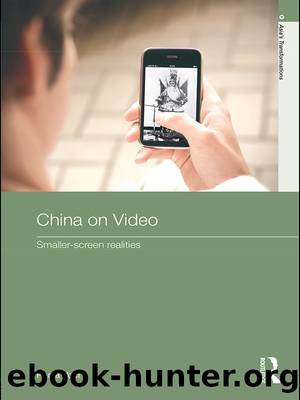China on Video by Voci Paola;Voci Paola;

Author:Voci, Paola;Voci, Paola;
Language: eng
Format: epub
Tags: Arts
Publisher: Taylor & Francis Group
Published: 2010-06-02T00:00:00+00:00
Documentary and politics
From Dziga Vertovâs theory of the kinoeye to the later development of direct cinema and cinéma verité theories and practices, the cameraâs power to see and show reality through a revealing technological mediation has been seen as an important first step towards understanding and changing society and, as such, also as a political tool.1 Specifically, political documentary generally refers to films with a militant spirit in support of, or in contrast to, the dominant ideology. The emphasis on political function has impacted on two mutually oppositional modes of representation. Political documentaries can develop an authoritative tone to disguise the fact that their ideological interpretation, arguably distortion, of reality is an irrefutable, self-evident truth. This mode of representation has been at the core of dominant, and often tyrannical, ideological propaganda. While dominant-ideology political documentaries tend to become formulaic and didactic, they are not necessarily dissociated from experimental and even avant-garde film practices. For instance, documentarians such as Dziga Vertov2 and Santiago Alvarez3 supported dominant ideologies while, at the same time, also experimenting with the modes of representation.
Conversely, in order to attack the hegemonic arrogance of the authoritative political documentary, dissenting political documentaries have either placed their faith in observational realism, consciously restraining their subjectivity in order to document reality more truthfully (Direct Cinema), or they have actively sought to disrupt the assumption of objectivity by emphatically exposing camera and editing manipulation (cinéma vérité). As a dissenting voice, political documentaryâs main impulse is to capture the realities that are traditionally ignored or misrepresented in mainstream media, making them visible and thus challenging the main ideology and its master narratives.4 Since many Chinese independent documentarians, one-person activists or accidental video journalists take inspiration, albeit with some significant variations and deviations, from this impulse, an examination of the politics of Direct Cinema and cinéma vérité can lead to some useful observations about the nature of the Chinese smaller-screen impulse towards the recording of reality.
In particular, the contexts within which these documentary theories and practices developed in the 1960s can help us to understand similar dynamics in the context of smaller-screen political documentary. When defining smaller-screen realities, I have argued against an emphasis on ânewâ media as the main defining attribute. However, I have also noted that the availability of new technologies is deeply interconnected with, though not determinant of, aesthetic changes in film and video-making. This is especially the case for cellflix, but also, to a lesser extent, for short animation or egao movies. The ânewâ medium becomes particularly relevant for the development of the form discussed in this chapter. DV technology and the Internet impact on the smaller-screen political documentary in ways similar to how lighter 16 mm camera impacted on Direct Cinema and cinéma vérité.5
As Michael Chanan has noted:
There is one thing in the history of documentary everyone seems to agree on. No one doubts that documentary changed radically at the start of the 1960s, apparently as a result of a technical breakthrough: a new generation of 16 mm cameras
Download
This site does not store any files on its server. We only index and link to content provided by other sites. Please contact the content providers to delete copyright contents if any and email us, we'll remove relevant links or contents immediately.
Technical Art History by Jehane Ragai(406)
Art, Science, and the Natural World in the Ancient Mediterranean, 300 BC to AD 100 by JOSHUA J. THOMAS(384)
Graphic Culture by Lerner Jillian;(373)
The Slavic Myths by Noah Charney(330)
Pollak's Arm by Hans von Trotha(305)
Treasuring the Gaze by Hanneke Grootenboer(305)
Simply Artificial Intelligence by Dorling Kindersley(302)
The Art of Portrait Drawing by Cuong i(295)
Drawing Landscapes by Barrington Barber(290)
Drawing for the Soul by Zoë Ingram(289)
The Art of Painting Sea Life in Watercolor by Maury Aaseng Hailey E. Herrera Louise De Masi and Ronald Pratt(276)
Sketchbook Confidential: Secrets from the private sketches of over 40 master artists by Editors of North Light Books(272)
Portrait of a Woman by Bridget Quinn(261)
Preparing Dinosaurs by Wylie Caitlin Donahue;(255)
A text-book of the history of painting by Van Dyke John Charles 1856-1932(254)
Anatomy for the Artist by Jennifer Crouch(252)
Mountain Manâs Field Guide to Grammar by Gary Spina(249)
Botanical Illustration by Valerie Price(245)
Egyptian art by Jean Capart(245)
